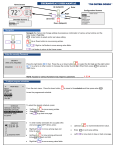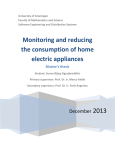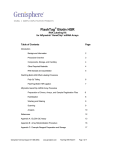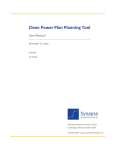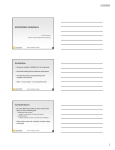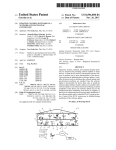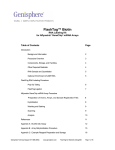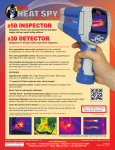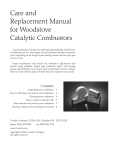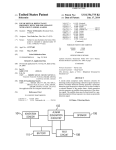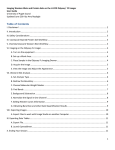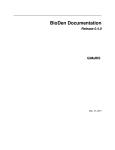Download Results from the E3T SRT FlashTAG
Transcript
Smart Residential Thermostats Results from the FlashTAG on December 20, 2012 Introduction The E3T program conducted its first FlashTAG by conference call and webinar on December 20, 2012 to discuss smart residential thermostats (programmable thermostats with web access). The primary goal of this technical advisory group (TAG) was to determine whether smart thermostats are likely to result in verifiable energy savings, and to identify what research needs to be done in order to incorporate them into BPA utility programs. Since 2009, E3T has convened five TAGs around major focus areas such as lighting, HVAC, and energy management. E3T recruited experts in the respective TAG focus areas and asked them as a group to identify technologies, products, and strategies with significant energy savings potential that are commercially available but not widely utilized in the Northwest region. Once identified, these emerging technologies (ETs) were rated and scored in surveys that also collected narrative information and comments from TAG members. The process generally has been conducted in a series of webinar meetings over a period of four to six months. Results of a standard TAG include ranked lists of all ETs considered, as well as detailed narratives, discussions about, and scores on six or fewer of the top-ranked ETs. With this information, recommendations were developed to identify gaps in the body of knowledge and to inform the process of conducting research and analysis necessary to approve the technology or practice as an energy efficiency measure eligible for utility incentives.. The FlashTAG concept arose to enable a specific aspect of a technology or group of technologies to benefit from expert review and assessment similar to standard TAGs. The Smart Residential Thermostat FlashTAG was launched in late November 2012, with plans for a single meeting of less than three hours. On December 5, 2012, past members from HVAC and Energy Management TAGs, plus select additional individuals already involved in informal discussions of the topic, were invited to participate in the 2012 Smart Residential Thermostat FlashTAG. TAG members were invited to an E3T Showcase webinar on the topic one day prior to the FlashTAG webinar, and were asked to use E3T web-based resources to familiarize themselves with current information on smart thermostats. The FlashTAG webinar discussion was the culminating event for the group and the primary results are the suggested research questions detailed below. Jack Zeiger; I:\E3T\Task 2-Advisory Groups\TAGs\Flash\SRT TAG Report DRAFT_rev 2-12-13 MTS.docx Page 1 of 7 2/21/2013 The 2012 E3T Smart Residential Thermostat FlashTAG Webinar The FlashTAG conference call consisted of information-sharing about the technology, questions and ideas for including the technologies in programs, and suggested research questions and approaches to verify their performance. This report is organized by general topic, noting the comments and questions that were raised around each topic. The topics include: • Heat Pump Control • Remote Access • Home Energy Reports and Savings Tips • Thermostat Products versus Features • Customer Issues – Usability and Customer Segmentation • Energy Savings and Persistence • Programmatic Issues • Secondary Research, Survey Ideas and Other Research A basic question before the TAG was whether the smart thermostats are worth pursuing as a measure for research or for utility efficiency programs. Smart thermostats are the next evolutionary step in technology beyond programmable thermostats. Programmable thermostats were looked on favorably when they first came out, but as studies came out showing that they did not save energy in many cases, utilities and the U.S. EPA began to regard them less favorably. In particular, EPA removed them from their list of ENERGY STAR-qualified products as of December 31, 2009. Do smart thermostats, with their increased capabilities, now offer something new that adds value over a programmable thermostat as an energy-saving device? According to the TAG’s initial brief survey, a majority of TAG members indicated support for pursuing smart thermostats, with no one opposed; however, several responses included reservations and uncertainties directly relevant to the FlashTAG’s primary goal of developing research questions. Heat Pump Control Much discussion centered on the potentially increased capabilities of smart thermostats to control heat pumps in a more efficient manner than current standard practice. Heat pumps represent large savings potential, and controls and installation continue to be significant challenges to acquiring reliable savings. This makes them a high-priority interest for some utilities due to the potential value smart thermostats can bring to the market. Questions that may be worth exploring for heat pump control are listed below. Research Questions • How much can you save by having the thermostat lock out the less efficient auxiliary heat (“strip heat”) at a lower temperature than manufacturer default or other, more standard, settings? • Do the approaches by the different thermostats to limit strip heat actually work as intended? • Can we save additional energy by tracking the local forecast to determine the best time to use a night setback and when to modify the user’s setback schedule? This would be measured primarily by how little the strip heat is used. • Should heat pump control go beyond minimizing strip heat? Maybe, considering performance curves, there would be other times that it makes sense to not set back the temperature so that Jack Zeiger; I:\E3T\Task 2-Advisory Groups\TAGs\Flash\SRT TAG Report DRAFT_rev 2-12-13 MTS.docx Page 2 of 7 2/21/2013 more of the heating can be done when it is warmer outside, when the heat pumps will run more efficiently. In some situations, it may rarely make sense to set back the temperature at night. • How much difference in energy savings is there between the Nest thermostat “comfort” setting versus the “economy” (more aggressive energy savings) setting? Remote Access Another feature of interest in smart thermostats is the possibility of remote access. One of the effects of programmable thermostats that make them somewhat less efficient than a conscientiously controlled manual thermostat is that some people may be less inclined to turn a programmable thermostat down when going away temporarily. Remote access capabilities could make it even easier and more attractive to turn the thermostat down than is possible with a manual thermostat. This capability has two advantages. One is that the user can turn down the thermostat while away if they forgot to turn it down before they left. The other is that users can turn the thermostat back up (or down) before they arrive home, so the home is comfortable when they arrive. This does not save energy, but it is a convenience that may encourage turning it down while away, and allows for changes when their return time is unknown or changes. In addition, most of the smart thermostats have an “away” mode that can be activated by simply pushing a button that puts it in setback mode until the user returns or directs it to return to occupied mode (perhaps remotely). Research Questions • How much more can you save with remote access versus a conventional programmable thermostat? • How much more likely are users to turn the thermostat down while away if they have remote access versus a conventional programmable thermostat? • How much “take back” (increased energy use) results from having the temperature come back to setpoint before the user arrives home? Is this worth it? • How persistent are these savings? Do people continue to use this feature six months later? A year? Longer? • What is the user experience? Is this feature useful? Do they use it? Is it fun? Annoying? Empowering? Home Energy Reports and Savings Tips To address these research questions, start with secondary research. Some work has already been done in this area. Research Questions • Is there measurable impact from providing reports to customers about their home energy use? This could be answered with secondary research, and the a priori answer is “yes.” This is well documented by studies done for Sacramento Municipal Utility District, Puget Sound Energy and Seattle City Light. • Is there a measurable impact of providing home energy-saving tips? Which tips are most useful or effective? Does the way in which the tips are communicated affect the results? Jack Zeiger; I:\E3T\Task 2-Advisory Groups\TAGs\Flash\SRT TAG Report DRAFT_rev 2-12-13 MTS.docx Page 3 of 7 2/21/2013 Thermostat Products versus Features One discussion that came up a couple of times is that it may make more sense to test each thermostat as a whole and see how much energy each one saves instead of trying categorize each thermostats by features or functions. One advantage of this approach is that it is not necessary to determine the savings mechanism. As long as installing a given thermostat saves energy on average, it gets an incentive. Some of the challenges of this approach include: • We have identified at least 24 smart thermostats on the market. Do we really need to test each one individually? Would it be cost-effective to test each one in enough homes to be statistically significant? Could they be grouped? How do we determine the groups if we are not categorizing them by features? • This technology is evolving so rapidly that it would be difficult for the incentive structure to keep pace with the technology. When a new model comes out, does it need to be tested again? Can we assume that each new version offers an energy-savings improvement, so even if they cannot be retested on a timely basis we can use the previous energy-savings estimates and incentive? Research Questions • What is the overall savings for each smart thermostat, or type of smart thermostat (not just certain features of each thermostat)? • Can the smart thermostats be categorized in a meaningful way (perhaps by key features)? Customer Issues – Usability and Customer Segmentation The TAG discussed several customer issues that impact potential adoption and savings from smart thermostats that involve usability, energy benefits and non-energy benefits. One of the overriding questions in this area is: Why are programmable thermostats often not being programmed at all? Most studies suggest that about half of programmable thermostats installed in homes are not being programmed by the users. Why does this happen and what can be done about it? Is that largely about usability issues? Non-energy benefits of installing smart thermostats include: • Ability to prevent freezing pipes by overriding programming if temperatures drop below freezing • Motion sensor can be used for other purposes (safety, health, lighting control) • Display outdoor temperature or indoor humidity • Visual appeal • Convenience Research Questions • The Nest thermostat has a unique user interface. The manufacturer claims that nearly 99 percent of their users are running some kind of program. Are other smart thermostats spurring users to program them because the interface makes this easy? How much overall energy savings do we get simply from having more users employ setbacks (because of ease of programming)? • Are homeowners’ current systems doing what they want them to do? • If not, how would they like their user-interface features to be different? Why do they not do setbacks? Jack Zeiger; I:\E3T\Task 2-Advisory Groups\TAGs\Flash\SRT TAG Report DRAFT_rev 2-12-13 MTS.docx Page 4 of 7 2/21/2013 • What other user-interface features encourage users to use the thermostat in an energy-saving manner? • One thermostat manufacturer (Lux) delivers new thermostats that are pre-programmed to a common setback program. How much does that help save? Do users tend to keep that program in place or replace it with their own program, or do some disable it? How long does that make a difference? • Does the voice-programmable feature (for Honeywell) or interview-based programming encourage users to program them? • Do thermostats that learn from a user’s manual input, or those with algorithms that learn about a home’s thermal performance and anticipate HVAC needs based on weather forecasts, provide more effective energy savings that those programmed fully by users? • Can we separate behavior savings from control savings? How much do savings vary based on the attitude of the customer? Energy Savings and Persistence The discussion covered many topics related to determining under what conditions and with what features energy use will a) decrease, b) decrease persistently, and c) increase. Features that could be responsible for decreasing or increasing energy use include: • Auto away • Setback • Locking out the resistance heating element in heat pumps • Remote control • Behavior • Predictive schedules (based on algorithms assessing observed patterns and probabilities • Optimization of efficiency (early start to use compressor rather than resistance, less setback, etc.) • Demand Response capability Research Questions • Which smart thermostat features generate savings that are most persistent, and how persistent are they? If we come back in six months or a year or two, is that feature still in use? • A related issue: how likely is it that, when the home is sold or re-rented, the new occupants will achieve the same savings as the occupants that originally had the smart thermostat installed? How likely is it that people will take their smart thermostats with them when they move? • What are the non-energy benefits of the smart thermostats? Are there reasons that people will continue to use these more effectively than standard programmable thermostats? Programmatic Issues • What are some of the programmatic questions that need to be answered or issues to be resolved? • What is the target market? Are we only including homes with forced air electric furnaces? Do we try to get such homeowners to install a better heat source (e.g., heat pumps) before we incentivize them to purchase a smart thermostat? Are heat pump owners a worthwhile target? Jack Zeiger; I:\E3T\Task 2-Advisory Groups\TAGs\Flash\SRT TAG Report DRAFT_rev 2-12-13 MTS.docx Page 5 of 7 2/21/2013 • What will happen with this market without utility intervention? What can utilities offer to help this market evolve in a way that is beneficial to utilities? For example, might the thermostats provide utilities with data they would not otherwise get? • How can research contribute to the upcoming ENERGY STAR Spec? Secondary Research, Survey Ideas and Other Research Smart thermostats have monitoring capabilities that will help answer research questions, which could include: • Tracking hours the heating equipment (compressor, furnace, resistance heating elements) is operating • Putting in a lock code so the owner cannot adjust the temperature settings • Tracking indoor temperature, outdoor temperature and relative humidity • Using monitoring data to help verify and evaluate weatherization and HVAC utility programs Research Questions • What is the baseline (default: a non-smart, code-compliant programmable thermostat)? • How are people using thermostats now? Why are some people not using setbacks? Some information has already been gathered in the recent Residential Building Stock Assessment performed by Ecotope. They found, for instance, that two-thirds of users are using setbacks. • Is there useful research we can do simply by analyzing existing data from different manufacturers of smart thermostats? Some manufacturers have very detailed data on smart thermostat operation for tens of thousands of homes. Accessing such data could save many thousands of dollars required to generate that data through demonstration projects. • Can some smart thermostats be used as a tool to help facilitate non-intrusive load monitoring (most cannot)? Can they monitor total household energy usage from a smart meter in real time, along with HVAC monitoring and control (Ecobee and maybe a few others can)? Can they monitor and even control other energy uses (i.e., various appliances) in the home as well? (Ecobee can interface with smart plugs, strips and outlets, but add-on sensors and modules can be expensive.) • Can smart thermostats be used to estimate the overall energy efficiency of a house to help identify the most promising homes for additional energy efficiency measures, such as weatherization? (This is being done by EcoFactor and maybe EnergyHub. Nest and probably others are capable of this. They also provide links on the web portal to utility incentive programs.) • Which thermostats have built-in diagnostics? (9 of 13 models surveyed provide maintenance alerts based on calendar time, equipment run time, or operating hours. Some have add-on accessories so you actually measure pressure drop across filters. This requires additional wireless sensors and more up-front and maintenance costs.) How much energy savings could this help achieve? Do these features provide additional non-energy savings? • At least two smart thermostats can provide control for multiple zones in a home. How much savings does this provide? • How does this research fit into priorities (compared to other research that could be done on other technologies)? • Define a protocol for testing new products. Jack Zeiger; I:\E3T\Task 2-Advisory Groups\TAGs\Flash\SRT TAG Report DRAFT_rev 2-12-13 MTS.docx Page 6 of 7 2/21/2013 • Who else is researching Smart Thermostats? Conduct further secondary research to glean results from these efforts. The TAG identified: Pacific Northwest National Laboratories Manufacturers Energy Trust of Oregon Secondary research identified the following: Sacramento Municipal Utility District U.S. Environmental Protection Agency Lawrence Berkeley National Laboratories NV Energy Gibson Electric Membership Corporation Mid-South Energy National Grid Just Energy Wisconsin Public Service Pacific Gas & Electric Reliant San Diego Gas & Electric Jack Zeiger; I:\E3T\Task 2-Advisory Groups\TAGs\Flash\SRT TAG Report DRAFT_rev 2-12-13 MTS.docx Page 7 of 7 2/21/2013







